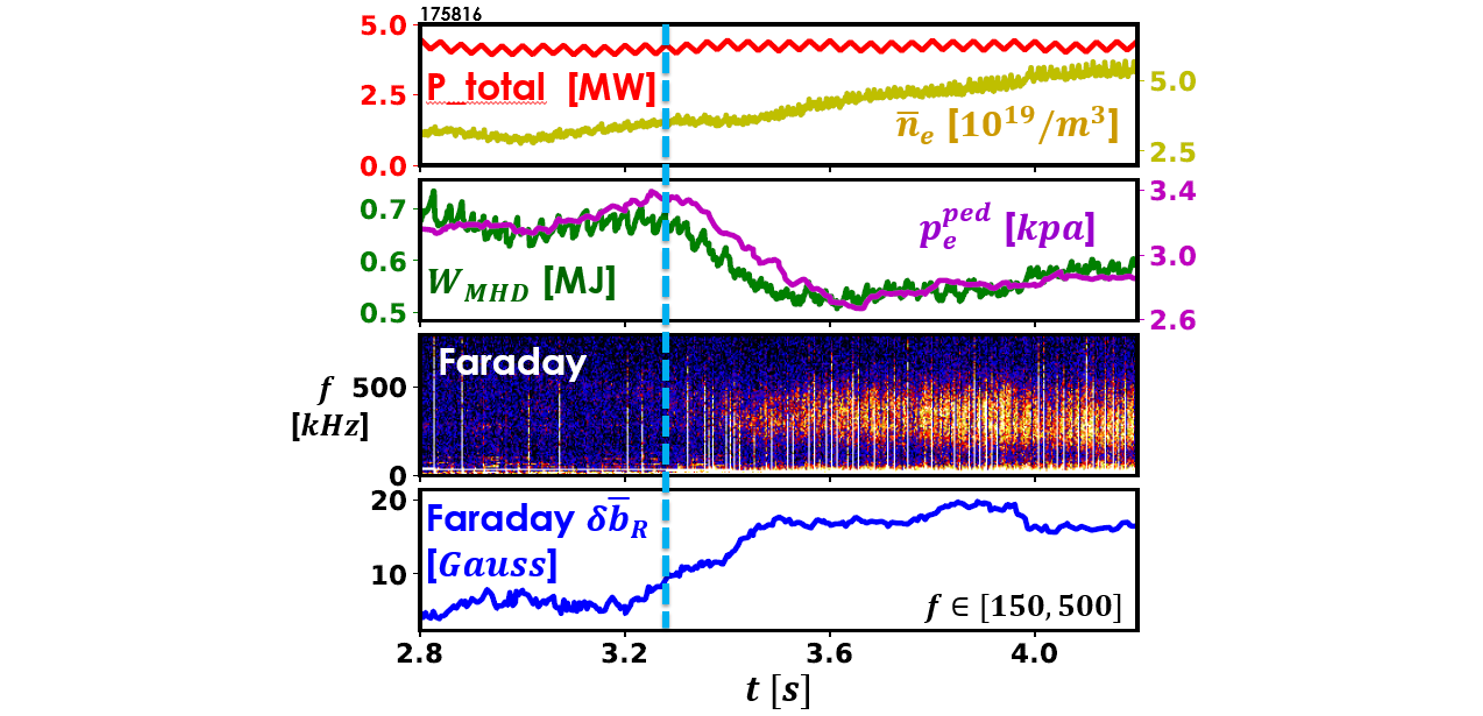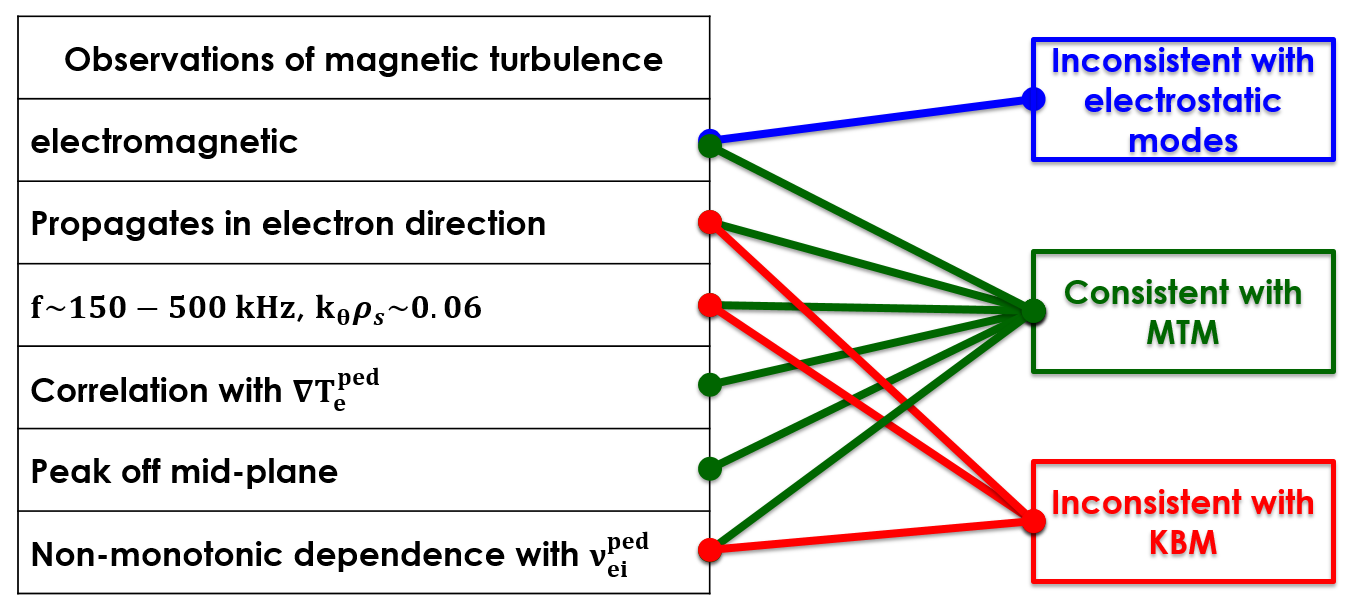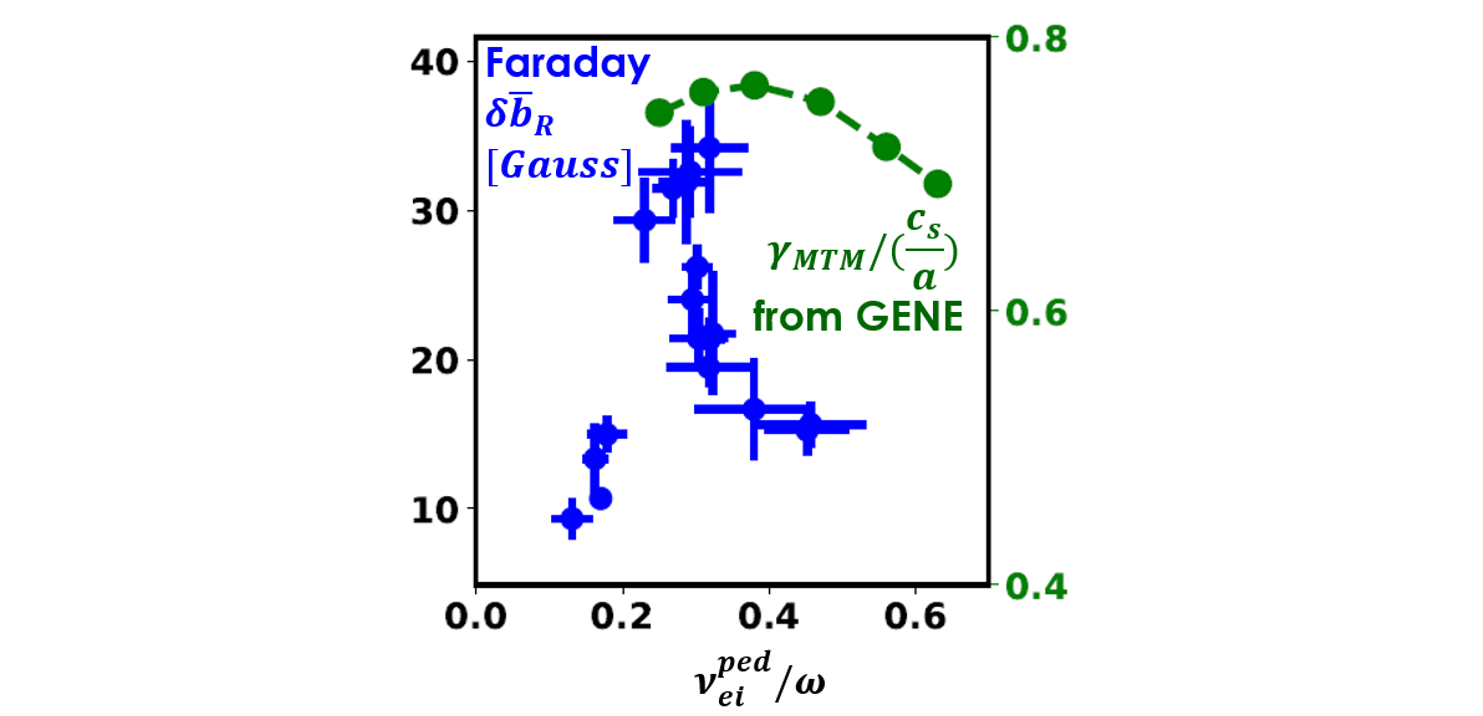Speaker
Description
Internal magnetic fluctuation measurements identify magnetic turbulence in the DIII-D ELMy H-mode pedestal as micro-tearing modes (MTM) and mode growth accompanied by degraded plasma confinement is observed. This work provides the first direct measurement of internal magnetic fluctuations supporting the prediction of gyro-kinetic simulations$^1$ that MTM exist in the H-mode pedestal. Using a Faraday-effect polarimeter, magnetic turbulence is observed in the edge of ELMy H-mode DIII-D plasmas. The turbulence amplitude correlates with confinement degradation in ELMy H-mode plasmas during a slow density ramp. Line-averaged fluctuation amplitude indicates the turbulence originates from electromagnetic instability. Frequency, poloidal wavenumber and propagation direction of the magnetic turbulence all agree with expectations for MTM. Magnetic turbulence amplitude non-monotonically correlates with collision frequency, peaks off mid-plane and correlates with temperature gradient evolution between ELMs, consistent with MTM features identified from theory and simulation. These internal measurements provide unique constraints towards validating models and developing physics understanding of H-mode pedestal in future devices.

Using a newly-developed high-speed Faraday-effect polarimeter, magnetic turbulence is observed to correlate with confinement degradation (Fig. 1). The polarimeter has been verified capable of directly measuring the absolute amplitude of line-averaged radial magnetic field fluctuations with wave number $k_\theta<1/cm$ and frequency up to 1 MHz. In an ELMy H-mode plasma with slow density ramp, the measured internal magnetic turbulence grows and saturates and is correlated with a ~20% drop in pedestal-top pressure and global plasma confinement. The line-averaged magnetic fluctuation amplitude after confinement degradation (>3.5 s) is ~20 Gauss over the full bandwidth, which could lead to the onset of a stochastic magnetic field and account for the observed confinement degradation, as expected for MTM.
Magnetic turbulence is observed in the edge of a wide range of ELMy H-mode DIII-D plasmas by the Faraday-effect polarimeter. Typically, the magnetic turbulence ranges from 100-500 kHz, peaking at 250 kHz. Magnetic fluctuations first appear ~2 ms after the ELM crash, grow quickly and then saturate before the next ELM event, correlating most closely with the evolution of pedestal electron temperature gradient. Density fluctuations in the same frequency range are observed simultaneously with similar temporal evolution between ELMs. BES shows the density fluctuation peaks in the pedestal steep gradient region, has wave number $k_\theta\sim0.3/cm$ ($k_\theta \rho_s\sim0.06$) and propagates in electron diamagnetic direction in plasma frame. Magnetic and density fluctuations measured by polarimeter at the same location show strong coherence up to 0.45 from 100-500 kHz, indicating they arise from the same instability.
Observations indicate the magnetic turbulence originates from electromagnetic instability. In a typical discharge, the line-averaged amplitude (averaged over the total chord length) of magnetic turbulence is 0.8 Gauss at the peak frequency and 15 Gauss integrated over the entire bandwidth (150-500 kHz). Corresponding lower-bound $|\delta b/B|$ is $4×10^{-5}$ and $8×{10}^{-4}$, respectively, and lower-bound $|\delta b/B|/|\delta n/n|$ is 0.08 and 0.15, respectively. These estimated values are comparable to that of electromagnetic instability from gyro-kinetic simulations (e.g. ref. 2).
The magnetic turbulence has been characterized and identified as MTM (Fig. 2). Theory predicts MTM are electromagnetic, propagate in electron diamagnetic direction with $k_\theta \rho_s\ll1$, driven by temperature gradient and saturate as $|\delta b/B|\simρ_e/L_{T_e},$ i.e. $\sim 1×10^{-3}$, all consistent with observations. Linear GENE calculation under the same experimental conditions find unstable MTM peak in the steep gradient region of the pedestal, with wavenumber and frequency quantitatively agreeing with the observed magnetic turbulence. The GENE simulation also shows non-monotonic collision frequency dependence of MTM growth rate, qualitatively consistent with the collision frequency dependence of turbulence amplitude in multiple shots (Fig. 3). The magnetic turbulence is always observed to peak off mid-plane, similar to MTM results from global GENE simulation$^3$.


This work provides the first direct measurement of internal magnetic fluctuations supporting the prediction of gyro-kinetic simulations that MTM exist in the H-mode pedestal. In addition, these measurements give critical constraints needed for model validation of pedestal predictions for future fusion devices. Work supported by the US Department of Energy under DE-FG03-01ER54615, DE-FC02-04ER54698 and DE-SC0018287.
References
1. M. Kotschenreuther et al., Nucl. Fusion 59, 096001 (2019)
2. W. Guttenfelder et al., Phys. Rev. Lett. 106, 155004 (2011)
3. D.Hatch et al., Nucl. Fusion 56, 104003 (2016)
| Affiliation | University of California Los Angeles |
|---|---|
| Country or International Organization | United States |
